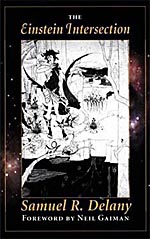
![]() thrak
thrak
1/16/2013
![]()
http://goldenapplesofthewest.blogspot.co.uk/2013/01/samuel-r-delany-einstein-intersection.html
"Endings to be useful must be inconclusive." Samuel R. Delany
'The Einstein Intersection' sure manages to get a lot done in the course of its slim 159 pages. Before embarking on the glorious impressionistic sprawl of 'Dhalgren', Samuel Delany's books were notable for the sheer power of imagination and narrative complexity that he was able to achieve within concise and punchy stories. Published between 'Babel-17' and 'Nova', Delany's other two long(ish)-form early masterpieces, 'The Einstein Intersection' sees him moving towards the open-ended complexity and ambiguity that characterises 'Dhalgren', whilst still maintaining all of his early clarity.
'The Einstein Intersection' is steeped in mythology and folklore, both ancient and not so ancient. The protagonist Lobey represents both Orpheus and Theseus, as he navigates his way through physical and metaphorical labyrinths to find a way to bring back his Eurydice, a deaf-mute telekinetic, from the dead. As you'd expect, music plays a central role, and in this case is actually a manifestation of Lobey's psychic powers. Along the way he encounters avatars of Billy The Kid and Jesus Christ. The text features quotations at the start of each chapter, from wide ranging and un-sci fi sources as James Joyce, Bob Dylan and Isidore Ducasse's 'Maldoror'. Additionally, some of the text is taken straight from the author's journal from the period when he was writing the novel, giving an unusual insight into the thoughts, experiences and processes that fed into the story's creation. In this way you can feel Delany moving towards the recursive metatextual surrealism of 'Dhalgren'.
The book is also a post-apocalypse yarn, in which humans have long since departed but aliens have taken use of their bodies to inherit the earth, which would be echoed in the central conceit of Gene Wolfe's 'The Fifth Head Of Cerberus' five years later. The characters are inhabiting bodies alien to them, on an alien world, and are afflicted by an outlandish variety of mutations. They themselves are frequently as confused as the reader is about the world they find themselves in.
Delany effortlessly weaves these two strands together at the heart of the novel, which is about the extent to which we do or do not inhabit the mythology of the past. Lobey knows that he represents Orpheus; he is told so several times during the narrative, and he knows how the story of Orpheus ends. But Lobey is not human; he is an alien wearing the shape of a human, and so he is wearing the shape of humanity's myths. In the section of the book where we learn the significance of the title, one of the characters asks Lobey what he knows about mythology:
"I don't want to know what's inside the myths, nor how they clang and set one another ringing, their glittering focuses, their limits and genesis. I want their shape, their texture, how they feel when you brush by them on a dark road, when you see them receding into the fog, their weight as they leap your shoulder from behind; I want to know how you take to the idea of carrying three when you already bear two."
Lobey thinks that he is predestined to fail, as the original Orpheus did before him. But each telling of the story is different. At the beginning of the book, Lobey doubts that Orpheus actually made his journey, reasoning that if he went he would have come back with Eurydice. At the corresponding point in his journey, it turns out that looking back was the correct decision, as what he had brought back with him was merely another illusion. While people, their lives and their stories change - we are not the same people as the ancient Greeks - mythology still holds a deep resonance for us. The characters in Lobey's world are unable to escape the pull of human mythology, trapped as they are in what remains of our bodies. Witness the fate of poor Green-eye, Delany's Christ stand-in, murdered as part of a ritual no one involved in understands. But that does not deny them the opportunity to ultimately decide their own fate.
http://goldenapplesofthewest.blogspot.co.uk/